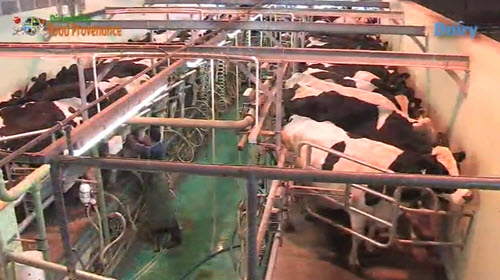
Milk and dairy products in the UK mainly come from cows and goats
The 2.3 million dairy cows in the UK, each produce an average of 5900 litres per annum.
Half of the milk is used for liquid consumption the rest being processed, into things like yogurt, cheese and butters. Use in cheese making accounts for half of all processed use.
Billy Bull
A bull is a male cow ( a female is called a cow!) If you see a field of cows and there is a bull in the field with them then he will usually be the largest animal in there. The best way to see a bull is from at distance or on our video as they can be very dangerous, as can cows especially if they have young calves and they feel you are a threat, especially if you are walking your dog! Because they can be dangerous they often have a ring through their nose so the farmer can have some control over them.
Cows will only mate with a bull at certain times – farmers say they are in season or on heat. The bull can tell this by sniffing the air or the cows wee which contains special chemicals called pheromones which tell the bull the cow is ready to mate.
Calving
Cows usually all calve around the same time on a particular farm – either Autumn or Spring. Farmers will often bring the cows inside to do this so they are easier to watch and help if they get into difficulties. Some cows do calve outside – if you are ever out walking and see a cow you think may be calving you should keep well clear as you may disturb here and she could also be very aggressive.
Preserving Grass
For various reasons dairy cows are usually kept inside over winter especially. During this period cows are fed on preserved grass. This can be in the form of hay which is just dried grass, but it is more usually in the form of silage.
Silage is ‘pickled’ grass basically the grass is placed in a clamp or more commonly now wrapped in plastic like in the video. This removes the air and means that the bacteria which would cause rotting – like with your grass cuttings, cannot function. Instead a different type of bacteria work on this grass converting the sugars in the grass to acid and effectively pickle it – sometimes the cut grass is inoculated with this type of bacteria to promote the correct type of fermentation.
Milking Cows

Cows are generally milked twice a day around 5 am and then again at 4pm. Dairy Cows soon get to know the daily routine and will enter the parlor with little prompting keen to release their milk.
The cows udders are cleaned to so that the milk does not become infected with any bacteria they may have picked up. It also gives the cow man a chance to check the cows health.
The teat cups are attached to the cows udders. These work on suction and must be checked regularly so that they work safely. The cows stand quietly whilst the milk is gently sucked from their teats.
The amount of milk a cow gives each day varies depending on what stage of lactation the cow is at – i.e. how long since she had her calf. The peak of lactation is around 5 weeks after birth when she could be giving around 40 litres of milk a day. Towards the end of lactation when she is about to finish milking to have the next calf this could drop to below 10 litres a day.
Other jobs of a stockman / woman or herds person.
The farmer does not just have to milk cows twice a day, but has many other jobs to do too. A farmer who looks after animals or stock as they are usually called – be they sheep, cattle or pigs, is often referred to as a STOCKMAN or WOMAN or sometimes a HERDSPERSON. In terms of milk production the Stockman in this case will sometimes be called the Dairyman.
Dairy Products
Milk is not just used as the ‘white stuff’, but used to make other dairy products such as cheese, butter and yogurt. Despite recent stories to the contrary diary products are fine as part of a healthy balanced diet